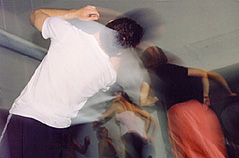Movement Metaphor
ACTIVITY

Pick a verb. Starting from a story or fragment of text, listen for a strong, active word; or find an undercurrent suggesting action and name that action with a verb. If working with a group, you may select one verb or make a list of three or four from which participants may choose. Or, if dancers have found or written their own texts, each may decide on his or her own word.
Take 10 to 15 minutes to find 20 ways to give movement to the verb. Consider the full range of options: interpretations of the word may be literal, associative, or punning; they may be based on a different meaning of the word from the one that inspired you to choose it; they may hold one position on the floor or move through space; they may engage one part of the body or the full body. Use all the options available; nothing is too small or too large to try; don’t be concerned with interpreting the story that was your starting point.
Have a showing. After you’ve taken the designated time to develop movements, dancers may show individually or in groups of two or three while other participants watch. Seek responses by asking “What did you observe,” with reference to generating the movements, performing them, or watching others.
APPLICATIONS
As an engine to generate movement vocabulary, Movement Metaphor is equally useful when applied solo, in small collaborative ensembles, or with large groups in community projects. When working from text or narrative material, it can be particularly helpful in inspiring more expansive, outward-moving enactments of ideas. It thus offers a useful balance to such tools as Equivalents and Detail which usually lead to more precise, gestural movement.
Various options can follow the basic exercise. The movements of one or more dancers may be layered with music or text; as usual, interesting connections often emerge when movement developed independent of a narrative is then attached, or reattached, to the narrative. Choosing from the volume of material the exercise yields, collaborators or participants may identify a few ideas that they want to develop. Energy, momentum, or emotion discovered through this process may contribute to developing content for new work, even if the movement itself gets discarded.
In work with children, Movement Metaphor can be adapted to offer auxiliary benefits in reinforcing learning about parts of speech and the multiple meanings of a single word.